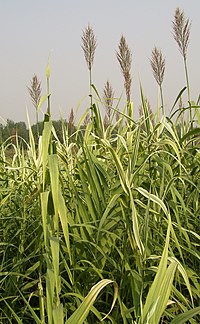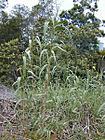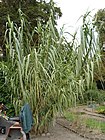Note: This is a project under development. The articles on this wiki are just being initiated and broadly incomplete. You can Help creating new pages.
Difference between revisions of "Arundo donax"
(→Identification) |
(→Habit) |
||
| (8 intermediate revisions by the same user not shown) | |||
| Line 1: | Line 1: | ||
[[File:Arundo donax 2007.JPG|200px|thumb|right]] | [[File:Arundo donax 2007.JPG|200px|thumb|right]] | ||
| + | '''Giant reed''' is a large perennial grass with elongated rhizomes. It produces erect, more or less woody, thin-walled stems 200 - 600cm tall. The plant has a wide range of applications and is often cultivated for use in basket making and to control soil erosion<ref name="Introduction"/> | ||
==Uses== | ==Uses== | ||
| − | {{Uses|Fever}}, {{Uses|Blood Pressure}}, {{Uses|To Improve breast milk}}<ref name="Karnataka Medicinal Plants"/>. | + | {{Uses|Fever}}, {{Uses|Blood Pressure}}, {{Uses|To Improve breast milk}}, {{Uses|Headache}}, {{Uses|Cancer}}.<ref name="Karnataka Medicinal Plants"/>. |
==Parts Used== | ==Parts Used== | ||
| − | {{Parts Used|Root}}<ref name="Karnataka Medicinal Plants"/>. | + | {{Parts Used|Root}}, {{Parts Used|Leaf}}, {{Parts Used|Rhizome}}<ref name="Karnataka Medicinal Plants"/>. |
==Chemical Composition== | ==Chemical Composition== | ||
| − | <ref name="chemical composition"/> | + | It contains Alpha-amyrin acetate, bufotenine, bufotenidine, campesterol, dehydro-bufotenine, N,N-dimethyltryptamine, donaxerin, friedelin, gramine, gramine methohydroxide, lupeol (anticancer), 5-metlioxy-N-methyl-tryptamine, sitosterol (antitumor), stigmasterol, triacontane and triacontanol have been reported.<ref name="chemical composition"/> |
==Common names== | ==Common names== | ||
| − | {{Common names|sa=Devanala, Nala|en=Great reed | + | {{Common names|sa=Devanala, Nala|en=Great reed|hi=Narcut nal|kn=Hulugilu Hullu, Lalada Kaddi|ta=Mudam Pullu|te=Adavi Kikkasagaddi}}<ref name="Karnataka Medicinal Plants"/> |
==Properties== | ==Properties== | ||
| Line 28: | Line 29: | ||
==Habit== | ==Habit== | ||
| − | {{Habit|}} | + | {{Habit|Evergreen Perennial}} |
==Identification== | ==Identification== | ||
| Line 47: | Line 48: | ||
==Mode of Propagation== | ==Mode of Propagation== | ||
| − | {{Propagation|}} | + | {{Propagation|Seed}}, {{Propagation|Stem cutting}}. |
==How to plant/cultivate== | ==How to plant/cultivate== | ||
| − | <ref name="How to plant/cultivate"/> | + | The plant is adapted to tropical, subtropical and warm temperate climates of the World. It is found in climates ranging from cool temperate wet; through tropical dry; to wet forest. The plant is reported to tolerate annual precipitation in the range of 300 - 4,000mm, an average annual temperature range of 9 - 28.5°c.<ref name="How to plant/cultivate"/> |
==Commonly seen growing in areas== | ==Commonly seen growing in areas== | ||
| − | {{Commonly seen|}}, {{Commonly seen|}}, {{Commonly seen| | + | {{Commonly seen|Ditches}}, {{Commonly seen|Riversides}}, {{Commonly seen|Marshland}}. |
==Photo Gallery== | ==Photo Gallery== | ||
| Line 67: | Line 68: | ||
==References== | ==References== | ||
<references> | <references> | ||
| − | <ref name="chemical composition"> | + | <ref name="chemical composition">Centre for New Crops and Plants products, Purdue Univesity</ref> |
| − | <ref name="Leaf">[Morphology" | + | <ref name="Leaf">[Morphology]</ref> |
| + | <ref name="Introduction">Tropical Plants Database, Ken Fern. tropical.theferns.info. 2022-03-29</ref> | ||
<ref name="How to plant/cultivate">[Cultivation]</ref> | <ref name="How to plant/cultivate">[Cultivation]</ref> | ||
<ref name="Karnataka Medicinal Plants">”Karnataka Medicinal Plants Volume-3” by Dr.M. R. Gurudeva, Page No.1137, Published by Divyachandra Prakashana, #6/7, Kaalika Soudha, Balepete cross, Bengaluru</ref> | <ref name="Karnataka Medicinal Plants">”Karnataka Medicinal Plants Volume-3” by Dr.M. R. Gurudeva, Page No.1137, Published by Divyachandra Prakashana, #6/7, Kaalika Soudha, Balepete cross, Bengaluru</ref> | ||
| Line 74: | Line 76: | ||
==External Links== | ==External Links== | ||
| − | * [ ] | + | * [https://www.invasiveplantatlas.org/subject.html?sub=3009 Arundo donax on Invasiveplantatlas.org] |
| − | * [ ] | + | * [https://hort.purdue.edu/newcrop/duke_energy/Arundo_donax.html Arundo donax on Hort.purdue] |
| − | * [ ] | + | * [https://indiabiodiversity.org/species/show/243164 Arundo donax on Indiabiodiversity.org] |
[[Category:Herbs]] | [[Category:Herbs]] | ||
[[Category:Pages without herbs images]] | [[Category:Pages without herbs images]] | ||
Latest revision as of 16:33, 5 December 2023
Giant reed is a large perennial grass with elongated rhizomes. It produces erect, more or less woody, thin-walled stems 200 - 600cm tall. The plant has a wide range of applications and is often cultivated for use in basket making and to control soil erosion[1]
Contents
- 1 Uses
- 2 Parts Used
- 3 Chemical Composition
- 4 Common names
- 5 Properties
- 6 Habit
- 7 Identification
- 8 List of Ayurvedic medicine in which the herb is used
- 9 Where to get the saplings
- 10 Mode of Propagation
- 11 How to plant/cultivate
- 12 Commonly seen growing in areas
- 13 Photo Gallery
- 14 References
- 15 External Links
Uses
Fever, Blood Pressure, To Improve breast milk, Headache, Cancer.[2].
Parts Used
Chemical Composition
It contains Alpha-amyrin acetate, bufotenine, bufotenidine, campesterol, dehydro-bufotenine, N,N-dimethyltryptamine, donaxerin, friedelin, gramine, gramine methohydroxide, lupeol (anticancer), 5-metlioxy-N-methyl-tryptamine, sitosterol (antitumor), stigmasterol, triacontane and triacontanol have been reported.[3]
Common names
| Language | Common name |
|---|---|
| Kannada | Hulugilu Hullu, Lalada Kaddi |
| Hindi | Narcut nal |
| Malayalam | NA |
| Tamil | Mudam Pullu |
| Telugu | Adavi Kikkasagaddi |
| Marathi | NA |
| Gujarathi | NA |
| Punjabi | NA |
| Kashmiri | NA |
| Sanskrit | Devanala, Nala |
| English | Great reed |
Properties
Reference: Dravya - Substance, Rasa - Taste, Guna - Qualities, Veerya - Potency, Vipaka - Post-digesion effect, Karma - Pharmacological activity, Prabhava - Therepeutics.
Dravya
Rasa
Guna
Veerya
Vipaka
Karma
Prabhava
Habit
Identification
Leaf
| Kind | Shape | Feature |
|---|---|---|
| Leaves are long | Flat | It can reach up to 20 ft in height. Although it can be much shorter when damaged or stressed. The stem resembles a corn stalk. |
Flower
| Type | Size | Color and composition | Stamen | More information |
|---|---|---|---|---|
| Dense | Large | Flowering from February to August |
Fruit
| Type | Size | Mass | Appearance | Seeds | More information |
|---|---|---|---|---|---|
| Fruiting from February to August |
Other features
List of Ayurvedic medicine in which the herb is used
Where to get the saplings
Mode of Propagation
How to plant/cultivate
The plant is adapted to tropical, subtropical and warm temperate climates of the World. It is found in climates ranging from cool temperate wet; through tropical dry; to wet forest. The plant is reported to tolerate annual precipitation in the range of 300 - 4,000mm, an average annual temperature range of 9 - 28.5°c.[5]
Commonly seen growing in areas
Ditches, Riversides, Marshland.
Photo Gallery
References
- ↑ Tropical Plants Database, Ken Fern. tropical.theferns.info. 2022-03-29
- ↑ 2.0 2.1 2.2 ”Karnataka Medicinal Plants Volume-3” by Dr.M. R. Gurudeva, Page No.1137, Published by Divyachandra Prakashana, #6/7, Kaalika Soudha, Balepete cross, Bengaluru
- ↑ Centre for New Crops and Plants products, Purdue Univesity
- ↑ [Morphology]
- ↑ [Cultivation]
External Links
- Ayurvedic Herbs known to be helpful to treat Fever
- Ayurvedic Herbs known to be helpful to treat Blood Pressure
- Ayurvedic Herbs known to be helpful to treat To Improve breast milk
- Ayurvedic Herbs known to be helpful to treat Headache
- Ayurvedic Herbs known to be helpful to treat Cancer
- Herbs with Root used in medicine
- Herbs with Leaf used in medicine
- Herbs with Rhizome used in medicine
- Herbs with common name in Kannada
- Herbs with common name in Hindi
- Herbs with common name in Tamil
- Herbs with common name in Telugu
- Herbs with common name in Sanskrit
- Herbs with common name in English
- Habit - Evergreen Perennial
- Index of Plants which can be propagated by Seed
- Index of Plants which can be propagated by Stem cutting
- Herbs that are commonly seen in the region of Ditches
- Herbs that are commonly seen in the region of Riversides
- Herbs that are commonly seen in the region of Marshland
- Herbs
- Pages without herbs images






